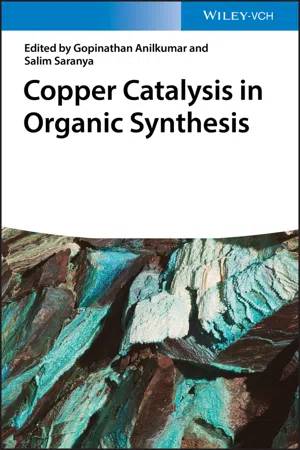Fundamental research has been the ladder toward great discoveries. The main objectives of fundamental research in chemical sciences involve understanding the basic principles and mechanisms involved in chemical processes, development of efficient and sustainable strategies with reduced, or without any, by-product(s), etc. Consequent to increased environmental concerns, methodologies consuming minimum energy and producing minimal waste should be developed. In this scenario, catalytic reactions emerge as vital and viable solutions and thus have attained an indisputable position to realize these goals. The different catalysis techniques involve homogeneous catalysis, heterogeneous catalysis, biocatalysis, etc. Among this, transition metal-catalyzed homogeneous and heterogeneous reactions are the most accepted ones. Transition metal-catalyzed reactions started with Glaser coupling when Carl Andreas Glaser reported the homocoupling of acetylenes in the presence of CuCl, NH4OH, and EtOH in 1869 [1]. Palladium-catalyzed reactions commenced in the beginning of 1900, but until the 1960s Pd chemistry remained largely unexplored. Afterwards, Pd catalysis received great attention and momentum due to its high catalytic activity, versatility, and ability to tune the reaction conditions. The exploration of other transition metals such as Rh, Ir, and Ru as catalysts also began in the 1920s. But the use of these metals had many drawbacks such as toxicity, high price, and low abundance. Hence the focus was turned toward much cheaper and cost-effective metal catalysts. In this context, copper chemistry has great importance owing to its low cost, high functional group tolerance, high abundance, and low toxicity. A search in Scifinder for various metal catalysts used for organic reactions revealed that Pd and Cu show the maximum number of publications (Figure 1.1). The average number of works reported per year during the period 1959–1999 for copper-catalyzed reactions was found to be 39; but it abruptly increased to 685 in the remaining 20 years attesting a renewed interest in this area of research (Figure 1.2).
Copper is a multifaceted transition metal that has been used by mankind from time immemorial. It is the second most earth-abundant element that occurs in nature in the form of ores and in a directly usable metallic form. Copper occurs as a soft orange-red colored metal present mostly as oxide, carbonate, and sulfate ores. The most common ore of copper is chalcopyrite, CuFeS2, which accounts for approximately 50% of the world's copper deposits. Examples of other copper-containing minerals are malachite, Cu2CO3(OH)2, a bright green ore, and the red cuprite, Cu2O, bornite, Cu5FeS4, covellite, CuS, chalcocite, Cu2S, and azurite, Cu3(CO3)2(OH)2 [2]. Copper derived its symbol (Cu) from the Latin word cuprum, meaning from the island of Cyprus, and has atomic number 29 with electronic configuration [Ar]3d104s1 and mass number 63.546 [3]. The presence of one electron in the s subshell above the filled d orbital makes copper more ductile and conductive (thermal as well as electrical). The characteristic color of copper results from the electronic transition between the filled d orbital and the half-filled 4s orbital. The low hardness and high ductility of single crystal copper is due to the lack of covalent character in its metallic bond [4]. One of the first examples of copper-based crafts is a pendant discovered in Northern Iraq, which dates back to around 8700 BCE [5]. Prehistoric man probably used copper for weapon making because of the availability and corrosion resistance of the metal. Later on, ancient Egyptians and Sumerians invented metallurgy, first reducing ores with fire and charcoal around 4000 BCE [6, 7]. They used copper bands and nails in ship building and copper pipes were used to convey water. Some of these artefacts have even survived until today. For example, archeologists have recovered a portion of a water plumbing system from the Pyramid of Cheops. The copper tubing used was found to be in serviceable condition after more than 5000 years! Furthermore, already at that time copper sulphate was used as a mordant in dyeing processes. It is estimated that the total Egyptian copper output over 1500 years was about 10 000 tons [8]. Around 2200 BCE, the first copper alloys appeared in Europe. Bronze, a copper–tin alloy, was followed later by brass (copper–zinc alloy). The “Bronze Age” saw the extensive use of copper and bronze for arms, coins, household utensils, furniture, and other items. In Roman times, the metal became known as aes Cyprium (aes being the generic Latin term for copper alloys such as bronze and other metals, and Cyprium because so much of it was mined in Cyprus). From this, the phrase was simplified to cuprum and then eventually Anglicized to copper. More recently, in modern times copper has played an important role in the advent of electricity and today, it is still among our most valued metals. Copper is an essential mineral needed by all living organisms. The human body contains about 1.4–2.1 mg copper per kg of body mass. With respect to function, copper occurs in a number of biological systems as pa...
